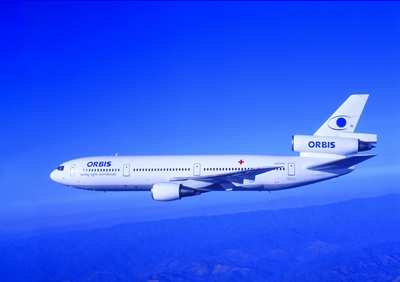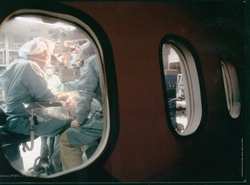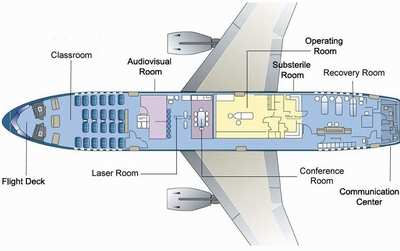First Appearance At Oshkosh Fly-In
 One of the world's most unique examples of a
humanitarian aircraft, the ORBIS Flying Eye Hospital, will make its
first appearance at EAA AirVenture Oshkosh in 2003, as the EAA
gathering is be held at Wittman Regional Airport in Oshkosh on July
29-August 4.
One of the world's most unique examples of a
humanitarian aircraft, the ORBIS Flying Eye Hospital, will make its
first appearance at EAA AirVenture Oshkosh in 2003, as the EAA
gathering is be held at Wittman Regional Airport in Oshkosh on July
29-August 4.
The ORBIS aircraft, a modified DC-10 airliner, flies to
developing nations around the world each year, working to save
sight through hands-on training, public health education, and
improved access to eye care. Since 1982, ORBIS has completed more
than 480 programs in 81 countries. It has trained in excess of
55,000 ophthalmologists, nurses, biomedical engineers and other
health care workers who, in turn, provide treatment and training in
their countries. Worldwide, more than 24,600 patients have been
directly treated by ORBIS volunteer doctors and more than 16
million people have received eye care from ORBIS-trained
doctors.

"We are very pleased to welcome the ORBIS DC-10 flying eye
hospital to EAA AirVenture this year," said Tom Poberezny,
President of the Experimental Aircraft Association and AirVenture
Chairman. "The outstanding work done by ORBIS and its volunteer
doctors is a shining example of how aviation has changed the world
over the first 100 years of powered flight. Through aviation,
thousands of people have saved one of their precious commodities -
their sight. We salute the work of those involved with the program
and hope people discover more about their work while the aircraft
is in Oshkosh."
 During EAA AirVenture 2003, the ORBIS DC-10 will
be parked on AeroShell Square, the event's showcase aircraft area.
The airplane will be open 9 a.m.-5 p.m. for tours each day,
allowing AirVenture visitors to learn more about ORBIS'
sight-saving work and how a large commercial airliner was
transformed into a working hospital. In addition, ORBIS will have a
small pavilion next to the aircraft that explains more about the
organization's work.
During EAA AirVenture 2003, the ORBIS DC-10 will
be parked on AeroShell Square, the event's showcase aircraft area.
The airplane will be open 9 a.m.-5 p.m. for tours each day,
allowing AirVenture visitors to learn more about ORBIS'
sight-saving work and how a large commercial airliner was
transformed into a working hospital. In addition, ORBIS will have a
small pavilion next to the aircraft that explains more about the
organization's work.
The idea for a flying eye hospital began in the mid-1970s when
Dr. David Paton, a Houston ophthalmologist, conceived the idea of
an airborne, ophthalmologic teaching hospital. He wanted to bring
American skills and expertise in ophthalmology to health personnel
in developing countries. The high costs of tuition, international
travel, and accommodations prevent the majority of doctors and
nurses in developing countries from participating in overseas
training programs. Even when they can afford to study abroad, their
opportunity for direct clinical experience is limited because
strict licensing laws often prevent them from performing
surgery.
The first ORBIS aircraft, a DC-8 donated by United Airlines,
took off on its first mission in 1982 when the staff of doctors,
nurses and administrators flew to 14 countries and held programs
that emphasized the hands-on transfer of surgical skills. Since
then, ORBIS has expended its curriculum to include
ophthalmologists, nurses, ophthalmic assistants, public health
workers and biomedical engineers. The DC-8 was replaced with a
fully outfitted DC-10 in 1994.

ORBIS is a non-aligned, non-profit global development
organization whose mission is to preserve and restore sight by
strengthening the capacity of local partners in their efforts to
prevent and treat blindness.
 NTSB Final Report: Cozy Cub
NTSB Final Report: Cozy Cub ANN FAQ: Contributing To Aero-TV
ANN FAQ: Contributing To Aero-TV Classic Aero-TV: Seated On The Edge Of Forever -- A PPC's Bird's Eye View
Classic Aero-TV: Seated On The Edge Of Forever -- A PPC's Bird's Eye View ANN's Daily Aero-Linx (04.29.25)
ANN's Daily Aero-Linx (04.29.25) ANN's Daily Aero-Term (04.29.25): Execute Missed Approach
ANN's Daily Aero-Term (04.29.25): Execute Missed Approach






